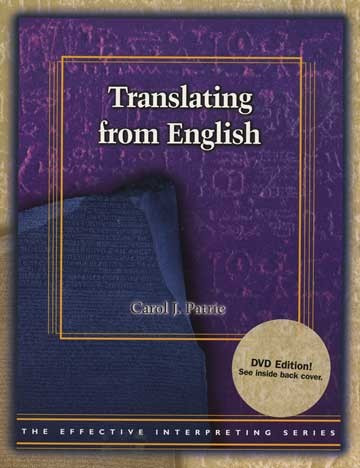 Loading... Please wait...
Loading... Please wait...- Visit Us: 8400 Menaul Blvd, Suite F, Albuquerque, NM 87112
- Home
- Books & Multimedia
- Interpreting
- Effective Interpreting: Translating from English (Study Set)
Shop our Store
Effective Interpreting: Translating from English (Study Set)
Product Description
What's the difference between translating and interpreting? Answer: Preparation and real-time - or simultaneous - delivery of information. Translators are trained to transfer a message from one language to another while preserving the meaning across language boundaries. They can also read the entire text or passage before translating, check other sources such as dictionaries, and revise the translation - solid groundwork for the more demanding task of interpreting in real time.
In Translating from English from The Effective Interpreting Series, top interpreter educator Carol Patrie encourages students and interpreters to use creativity and a range of linguistic resources to come up with a faithful translation without the pressure of real-time processing. Learning to translate effectively can be a stepping stone to real-time or simultaneous interpretation. It can also be a worthy and rewarding career in its own right, as shown by the translators who are much in demand at the United Nations, in business, in government, and in the academic world.
The Study Set includes helpful theoretical Introductions for each topic, Study Questions, a structured Five-Step Follow-up, and a Progress Tracking Sheet.
Topics include:
Translating from English can be used as an independent study course. Earn CEUs (Continuing Education Units) at home, on your own time, at your own pace!
[Study Set: Carol J. Patrie, Ph.D.; Workbook: 224 pages; soft cover; DVD/VHS: 30 minutes; closed captioned; audio]
Not returnable once opened.
In Translating from English from The Effective Interpreting Series, top interpreter educator Carol Patrie encourages students and interpreters to use creativity and a range of linguistic resources to come up with a faithful translation without the pressure of real-time processing. Learning to translate effectively can be a stepping stone to real-time or simultaneous interpretation. It can also be a worthy and rewarding career in its own right, as shown by the translators who are much in demand at the United Nations, in business, in government, and in the academic world.
The Study Set includes helpful theoretical Introductions for each topic, Study Questions, a structured Five-Step Follow-up, and a Progress Tracking Sheet.
Topics include:
- Preparing to Translate
- Analyzing the Meaning of the Text
- Message Transfer
- Reformulating the Message
- Priorities in Translation
- Testing the Translation
Translating from English can be used as an independent study course. Earn CEUs (Continuing Education Units) at home, on your own time, at your own pace!
[Study Set: Carol J. Patrie, Ph.D.; Workbook: 224 pages; soft cover; DVD/VHS: 30 minutes; closed captioned; audio]
Not returnable once opened.



